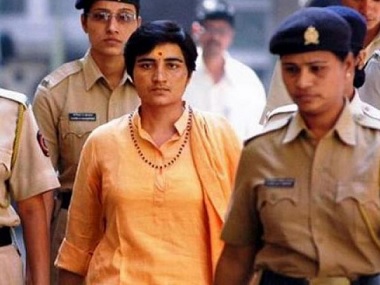The National Investigation Agency (NIA) was left red faced on Thursday as the trial court said that Sadhvi Pragya Thakur, Lieutenant Colonel Prasad Purohit, and six other accused in the Malegaon blast case, will face trial on stringent terror charges in the politically-sensitive case that had raised speculation of saffron militancy. The court, however, dropped the stringent Maharashtra Control of Organised Crime Act (MCOCA) charges against the accused, which is punishable by up to life in prison. The accused will now six others will face trial under Section 18 (conspiracy) of the Unlawful Activities Prevention (UAPA) Act and other sections of the Indian Penal Code (IPC). Apart from Sadhvi and Purohit, the other accused who received partial relief in the case are Ramesh Upadhyay, Sameer Kulkarni, and Sudhakar Dwivedi. The court also discharged Pravin Takalki, Shyamlal Sahu, and Shivnarayan Kalsangra from the blast case, whereas Rakesh Dhawde and Jagdish Mhatre will face trial only under the Arms Act. The court said the accused persons will face trial under sections 16 (committing a terror act) and 18 (criminal conspiracy) of the Unlawful Activities Prevention Act (UAPA), and sections 120(b) (punishment of criminal conspiracy), 302 (murder), 307 (attempt to murder) and 326 (intentionally causing harm to others) of the IPC. Significantly, the court dismissed NIA’s contention that there was no evidence against Sadhvi Pragya, saying it was difficult to accept the claim given that her motorcycle was used in the blast. “There is evidence to suggest that the accused number one (Thakur) had knowledge about the involvement of her motorcycle,” the court said in its ruling on the nine-year-old case that had raised worries of Hindu militancy gaining a foothold as a reaction to Islamic extremism. Sadhvi Pragya “had also expressed dissatisfaction about causing few casualties in the blast. Hence it is difficult to accept submissions on behalf of the NIA and the accused number one that she had no concern with the present crime,” it said. The NIA, while filing a charge sheet in the case last year, gave a clean chit to Sadhvi Pragya and three others saying it found no evidence against them and they should be discharged from the case All the above accused
filed pleas to be discharged from the case, which the court rejected. However, the court agreed that MCOCA charges should be dropped. The next hearing in the case will be held on 15 January. [caption id=“attachment_2860800” align=“alignleft” width=“380”] File image of Sadhvi Pragya. PTI[/caption]
“The UAPA sections 17 (raising funds for a terrorist organisation or a terrorist attack), 20 (being part of a terrorist organisation) and 23 (aiding somebody who is part of a terrorist organisation) have been dropped against all accused,” special NIA judge SD Tekale said. MCOCA is a stringent law in the state of Maharashtra which can be invoked only after the police can prove that the gang is organised and committing crime for pecuniary gains. It is also mandatory that at least two separate charge sheets have been filed against the accused people in the last ten years to slap MCOCA charges.
Under the MCOCA, an accused cannot obtain bail easily. Once these charges are invoked, the police is liable to get custody for the accused for a maximum of 30 days, as opposed to the 14-day limit under the Indian Penal Code (IPC). The accused is subject to a minimum of five-year imprisonment and a maximum of death sentence, if the charges are proven. Under MCOCA, the police also gets the leeway to file a charge sheet within 180 days, as opposed to the 60 to 90 day window under IPC. The law is essentially based on the premise that the accused will be considered guilty until proven innocent. However, in the Malegaon blast case, all accused are already out on bail and the NIA court said that all the previous bonds and sureties submitted by them will continue. The case has seen various twists and turns as the investigation was passed on to various agencies. Soon after the blast in Malegaon, a town in north Maharashtra with a sizeable Muslim population, the Anti-Terrorism Squad (ATS), which probed the case first, booked Noorul Huda, Raees Ahmed, Salman Farsi, Farogh Magdumi, Shaikh Mohammed Ali, Asif Khan, Mohammed Zahid, Abrar Ahmed and Shabbir Masiullah Batteriwala for the blast which claimed six lives when an improvised explosive device strapped to a motorcycle went off while 101 persons were injured. The CBI took over the case a year later, and endorsed the line of investigation taken by ATS. However, the NIA, to which the probe was transferred in 2011, filed a charge sheet absolving them of all charges, and instead named four others, including Sadhvi Pragya and Colonel Purohit, who were members of a Hindu extremist organisation. Following this, in April last year, a special court in Mumbai discharged them from the case, as the NIA submitted that it had found no evidence against them. The ATS moved the Bombay High Court against the trial court’s order, terming it as contrary to the evidence on record. Assistant Public Prosecutor Mankunwar Deshmukh, ATS counsel, told the court that the special court order had “no legal basis”. A powerful bomb exploded near the crowded Nooraji Mosque in Malegaon on the evening of 29 September, 2008, killing six and injuring 100 others, around 300 kilometres north of Mumbai in Nashik district. It was the second such blast in the Muslim-dominated powerloom town which was earlier shaken by a similar blast on 8 September, 2006, which claimed 37 lives and injured more than 250. Initially, the 2008 case was probed by the Maharashtra Police and the ATS. In April 2011, it was taken over by the NIA. The investigators had charge-sheeted 14 accused in the case, including two — Ramchandra Kalsangra and Sandeep Dange — who are absconding. The involvement of some of the accused was found in other terror acts in the country. With inputs from agencies


)




